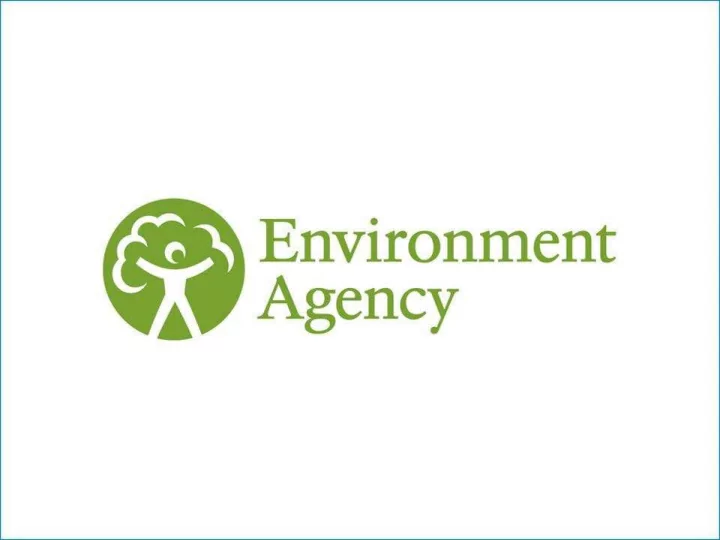

Farm inspections Becky Hibbert Environment Officer - Agriculture
The Environment Agency Flood Risk Management Water Resources Fisheries, Conservation & Biodiversity Navigation & Recreation Radioactive substances Environment Management
Content Farm selection How we regulate The farm inspection What if we find something wrong..
Farm Selection Water Framework Directive Known issues and incident reports Other evidence of risk High risk crops
Incident Response and Follow up We received 2585 slurry store related incident reports between 2001 and 2012 6
How we Regulate Cross Compliance now done by RPA We target farms based on evidence Pragmatic approach to reduce pollution Farm visits Discuss issues that impact the environment Identify legislative requirements which are not being met Give advice and guidance to address these Work with you to agree an action plan Post visit letter with action plan Enforcement action
Post- visit letter with action plan
‘Conventional’ regulation Nitrate Pollution Prevention Regulations 2008 (NVZ) Sludge Use in Agriculture Regulations 1989 SSAFO, as amended 2010 etc. EPR 2010 IPPC Pigs and Poultry Former Groundwater Authorisations Waste Management (Exemptions, Mobile Plant) Hazardous Waste Water Abstractions (especially Spray Irrigation) Radioactive Substances Act 1993 UNCLASSIFIED 9
What might you be asked to discuss during a visit? Nutrient management and efficiency Farm infrastructure Soil management and structure Yard drainage Connectivity to Rivers Farm tracks Vehicle wash areas Pesticide storage and handling
Nitrate Pollution Prevention Regulations 2008 (NVZ)
Nitrate Pollution prevention Regulations 2008 (NVZ) New changes Must provide 5/6 months storage of slurries Tougher response to lack of storage No records No risk map
Nutrient Management Planning Nitrogen use – the four stage plan Proof of assessing soil nitrogen supply (SNS) Assessment of crop need Calculate available N from organic manure applications Calculate amount of bagged N needed
Nutrient Management Nutrient sampling Are P and K at target indices (2-2+)?
Options for storage of FYM Field heaps: no more than 12 months, No return for 2 years, Not with 10m of water course or field drains. Mark on risk map. In yard storage: On concrete (not cracked) with run off contained. Runoff may be low in N but is still high BOD. Minimise surface area of the field heap.
Dirty water Dirty water – Mostly water with some sediment/dung contamination from lightly contaminated yards. Low in N and P. No closed periods but is still contaminating. Do not allow cattle feeding areas (Slurry) to wash to soakaways.
Control of Pollution (Silage, Slurry and Agricultural Fuel Oils) Regs 1991 (SSAFO) Control building and design of Storage facilities. Applies to all structures post-1991
SSAFO A fifth of slurry stores inspected by the EA in 2012/early 2013 were deemed non complaint with the SSAFO storage volume (4 months), of which 36% were judged to be causing environmental harm
SSAFO - Silage Impermeable Silage made walls with no at >30% DM gaps strong to reduce enough to leachate take weight Impermeable surface Drainage resistant to channel to acidic contain any conditions leachate Rain running through the silage after silage is unwrapped is dirty water.
SSAFO - Silage No perimeter drains to No effluent collection tank collect effluent
SSAFO – Fuel oil Location out of the way so it cannot be knocked over Bunded fuel tank in good condition All pipe work inside the bund and locked Impermeable away base to prevent ground contamination
SSAFO – Fuel oil Rusting fit for purpose? No bund No lock to prevent Pipework is unauthorised out side of access a bund Dripping tap Surface will soak into water the ground drain
SSAFFO – Fuel oil This surface water drain is directly below the fuel filling area. Move it or have emergency covers.
SSAFO - Slurry storage Must be Tank able to must be contain 4 built to months 20 year storage standard Reception pit. Must be 2 days capacity and have cut off valves
SSAFO - Slurry storage Not within 10m of watercourse Suitable soil – 20-30% clay Impermeable soil at Impermeable soil - least 1m thick at base <0.000001mm per second.
Yard Drainage Surface and foul water separation Concrete condition Sediment trapping Vehicle wash areas
Pesticides storage and handling Spraying operations Buffer zones Management of pesticide washings Certification Pesticides are high risk for watercourses Biobed
Connectivity to water courses High risk activities Pathways for Soil management and sediments slope
Soil Management Soil Protection review Farm tracks Poaching Track before River banks Compaction Run-off Track after
Livestock access to watercourses Damage to bank Sediment released into watercourse Faeces in watercourse Poaching Run off
Benefits to restricting livestock access to watercourses Complies with GAEC1- soil protection review so no loss of SFP In line with code of good agricultural practice Reduce risk of erosion Reduced risk to livestock of waterborne diseases and injury
Potential Solutions Mains water trough Pasture pump
Potential Solutions Cattle drinking bay •Post and rail fencing; • Access ramps with max. 1:4 slope; • Drinking bays at least 3m wide; • Stone or hardcore base.
Sludge regulations and land spreading Control of the PTEs. Be aware it is your responsibility to know what nutrients are in the soil and if you can take the waste. We permit land spreading of waste to land (e.g. Food, compost). Permit SR2010No4 and exemptionU10/U11 required.
EPR waste exemptions New exemption system Need to check the criteria of the new exemption Register online for free Should be done 1 st Oct 2013
What happens if we find non compliant issues We want to raise awareness of pollution risks. Will work with you to find a solution. We may point you to sources of support. We can take enforcement action/RPA. Please take any advice that is given.
Any Questions? Useful info • Nitrate Vulnerable Zones in England: guidance on complying with the rules for 2013 to 2016 https://www.gov.uk/government/publications/nitrate-vulnerable- zones-in-england-guidance-on-complying-with-the-rules-for- 2013-to-2016 • Registering waste exemptions online http://www.environment- agency.gov.uk/business/sectors/32779.aspx • Any questions in the future – pick up the phone or email us, come and see me for my contact card
Recommend
More recommend